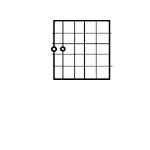Louddog
Member
I play with a guy that uses this chord alot. I know it is probably a partial chord, but what do you guys think the voicing is? I use this,obviously, when we do drop d tunning, but this is standard tuning. He uses this when he pedals off the Low E, and moves it up and down the fretboard. I think he wants this to sound like a G, but I say its more a C. I really just think it sounds bad, but I'd like to explain to him why.
Doug
Doug



 ).
).